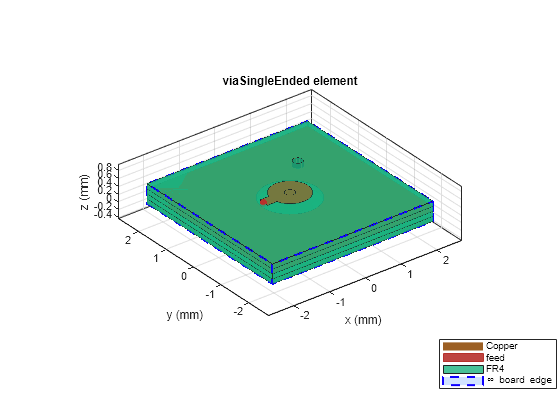getantipads
Description
Examples
getantipads of Single Ended Via
This example shows how to use the getantipads function to generate an antipads stack
via = viaSingleEnded
via =
viaSingleEnded with properties:
Conducting Layers
SignalLayer: [1 7]
GroundLayer: [3 5 9]
Conductor: [1x1 metal]
Dielectric Layers
Substrate: [1x1 dielectric]
Signal Vias
SignalViaLocations: [0 0 1 9]
SignalViaDiameter: 2.5000e-04
SignalViaFinishedDiameter: 2.0000e-04
SignalViaPad: [1x1 shape.Circle]
RemoveUnusedPads: 1
SignalViaAntipad: [1x1 shape.Circle]
Ground Return Vias
GroundReturnViaLocations: [1.0000e-03 1.0000e-03 1 9]
GroundReturnViaDiameter: 2.5000e-04
GroundReturnViaFinishedDiameter: 2.0000e-04
Ports
SignalTable: {2x4 cell}
propVal = getantipads(via)
propVal=1×3 cell array
{1x1 shape.Circle} {1x1 shape.Circle} {1x1 shape.Circle}
show(via)

Input Arguments
pcbobject — Single ended via
single ended via object (default)
Example: via=viaSingleEnded; propVal =
getantipads(via)
Data Types: sigle ended via
Output Arguments
propVal — antipads stack
antipads stack
getantipads returns an antipad stack of size
SignalViaLocations-by- GroundLayer in the
via. The first non-empty shape from obj.SignalViaAntipad is used for
scalar expansion to build the antipad stack.
Version History
Introduced in R2024a
MATLAB Command
You clicked a link that corresponds to this MATLAB command:
Run the command by entering it in the MATLAB Command Window. Web browsers do not support MATLAB commands.

Select a Web Site
Choose a web site to get translated content where available and see local events and offers. Based on your location, we recommend that you select: .
You can also select a web site from the following list
How to Get Best Site Performance
Select the China site (in Chinese or English) for best site performance. Other MathWorks country sites are not optimized for visits from your location.
Americas
- América Latina (Español)
- Canada (English)
- United States (English)
Europe
- Belgium (English)
- Denmark (English)
- Deutschland (Deutsch)
- España (Español)
- Finland (English)
- France (Français)
- Ireland (English)
- Italia (Italiano)
- Luxembourg (English)
- Netherlands (English)
- Norway (English)
- Österreich (Deutsch)
- Portugal (English)
- Sweden (English)
- Switzerland
- United Kingdom (English)
Asia Pacific
- Australia (English)
- India (English)
- New Zealand (English)
- 中国
- 日本Japanese (日本語)
- 한국Korean (한국어)